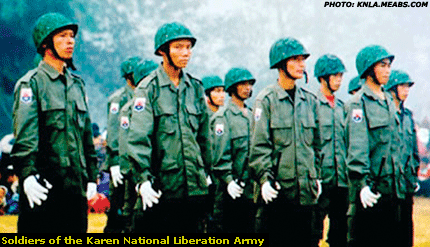The troops of KNLA Battalion 101 stick to their guns
When Saya Lay was a student, he knew the soldiers of the Karen National Union simply as “rebels,” or thu boun. “I didn’t think of them as human beings, and I believed they had horns.” At 24, Saya Lay now sees the rebels in a different light. He is chief medic for the Karen National Liberation Army’s Battalion 101.
 Sporting a Karen-patterned black vest and short-cropped hair, Saya Lay begins his day at the small clinic in Karen State’s 7th Brigade by tidying up the rooms and preparing breakfast for a group of friends. The clinic is a small wooden structure with a leafed roof. The medic’s meager supplies are stored in a cabinet in one corner of the office and include equipment for testing blood samples for the presence of malaria. He picks up a handmade wooden pillow. “The man who made this for me finished his duty [with the KNLA], but we are not yet finished with ours.”
Sporting a Karen-patterned black vest and short-cropped hair, Saya Lay begins his day at the small clinic in Karen State’s 7th Brigade by tidying up the rooms and preparing breakfast for a group of friends. The clinic is a small wooden structure with a leafed roof. The medic’s meager supplies are stored in a cabinet in one corner of the office and include equipment for testing blood samples for the presence of malaria. He picks up a handmade wooden pillow. “The man who made this for me finished his duty [with the KNLA], but we are not yet finished with ours.”
Saya Lay’s duty began more than five years ago, when he decided to join the ranks of Karen State’s armed ethnic opposition. Hatred of the Burma Army, who had killed his uncle for suspected collaboration with the region’s opposition forces, drove him from his home in Kyauk Kyi Township in Pegu Division. Other family members as well suffered oppression by government troops and their proxies.
The Democratic Karen Buddhist Army, a splinter group of the KNLA which reached a ceasefire agreement with Burma’s State Peace and Development Council in 1995, has for nearly a decade exploited local villagers for its own gain and under the protection of Rangoon. Saya Lay’s father was severely beaten by a group of soldiers when he and other relatives arrived late at a location where villagers were being forced to work. He remains in fragile health and has undergone two operations on his back as a result of the beating.
Motivated by the pain inflicted on his family and the broader struggles of Burma’s Karen ethnic minority, Saya Lay chose to fight for his people. His ambition of becoming a doctor took an unconventional turn. Rather than the laboratories and classrooms of a traditional medical school, he learned his trade on the front lines of Burma’s longest-running civil war.
The KNU is one of Burma’s oldest and strongest armed ethnic opposition groups, and it has waged war with successive administrations of the Burmese government since 1949. Government troops overran KNU headquarters at Manerplaw in 1995, and since that time the group has lost ground in its fight for greater regional autonomy.

In the last decade, other political developments have weakened the KNU. Neighboring Thailand had for many years adopted a policy of tacit collaboration with the Karen and other armed ethnic minority groups along the Thai-Burma border, hoping that they would establish a buffer zone against any encroachment by Burmese forces. This policy has changed in recent years as Thailand seeks to strengthen its economic and political ties with Rangoon. Despite more than a half century of armed conflict, the KNU has since 1995 made several efforts to open diplomatic lines of communication with Burma’s ruling junta to negotiate an equitable ceasefire agreement. In 2004, then deputy chairman Gen Bo Mya flew to Rangoon to hold peace talks with ex-prime minister Gen Khin Nyunt. The meeting—backed by some of Thailand’s top military and business leaders—produced a “gentleman’s agreement” to end hostilities in Karen State. Khin Nyunt’s subsequent ouster later in the year, however, ended any momentum towards an official ceasefire.
Moreover, the “gentleman’s agreement” proved less than gentlemanly. Though fighting did cease in the two or three months following the Rangoon meeting and ethnic forces enjoyed more freedom of movement in Karen-controlled regions, fighting soon resumed—as did the government’s consistent practice of conscripting local villagers for forced labor.
“We do not actively engage Burmese soldiers because of the peace talks,” said one of the soldiers of Battalion 101. “We try to keep away from them, but they always find us and attack.”
According to Saya Lay, the SPDC has slowly chipped away at Karen-controlled areas in recent months by increasing its presence and continuing to engage rebel forces.
“The ceasefire talks are a good way to work toward peace, but they [SPDC] must honor their agreements,” said another soldier of Battalion 101. “We are now losing more and more of our territory,” he added. “They are saying one thing and doing another.”
Despite increased aggression by government forces, Karen rebels have continued to avoid engaging them. “Our leaders have ordered us not to break our promise, even if they [SPDC] break theirs,” said Saya Lay, adding that this is not always possible when government troops launch a direct assault.
“For me, I don’t want to keep away when I see them,” said Saya Lay. “I would rather fight them because I know that if they see us first, they would never keep away from us. But I don’t go looking for a fight.”
“We are soldiers,” he added. “We must listen to our leaders.”

 Sporting a Karen-patterned black vest and short-cropped hair, Saya Lay begins his day at the small clinic in
Sporting a Karen-patterned black vest and short-cropped hair, Saya Lay begins his day at the small clinic in 